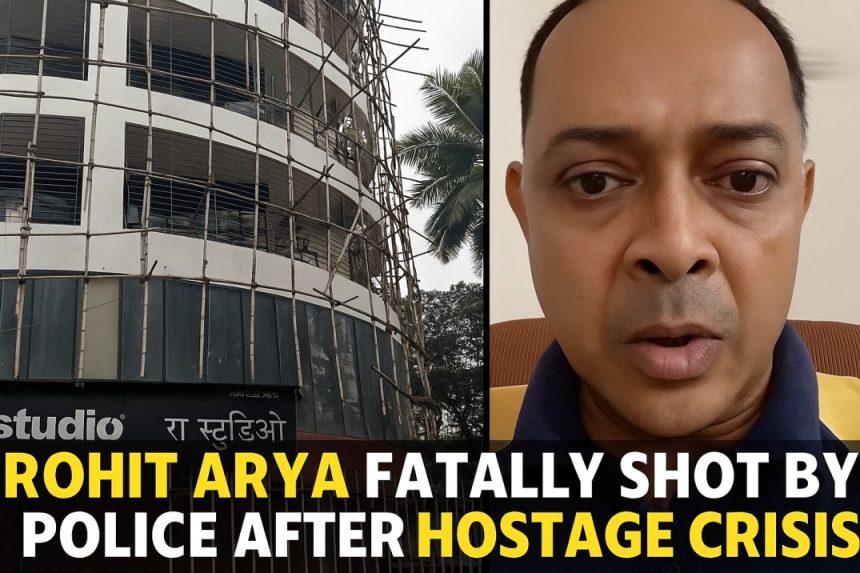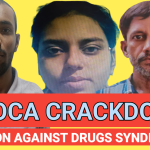By | Arvind Jadhav | Exclusive
Mumbai: A tense Thursday afternoon in Mumbai turned into a scene of chaos and disbelief when a self-proclaimed filmmaker, Rohit Arya, held nineteen people, including seventeen children, hostage inside a small studio in Powai. What began as an apparent audition for a children’s web series quickly escalated into one of Mumbai’s most dramatic police operations in recent years — ending with Arya’s death in a police encounter.
Rohit Arya, aged fifty, was known among small creative circles as a filmmaker and social campaigner. He had been involved in school awareness projects such as “My School, Beautiful School,” a cleanliness and education initiative linked to the Swachhta Monitor campaign. Arya had long claimed that he was owed nearly two crore rupees for his work under this project. He alleged that the government had used his material but never paid him for it. Frustrated, disillusioned, and emotionally unstable, Arya reportedly decided to make one last, desperate attempt to draw attention to his plight.
Police sources and eyewitness accounts suggest that Arya had meticulously planned the incident. He circulated posters and online messages inviting children for a casting session for a supposed educational film. Parents arrived in good faith, unaware that the audition was a trap. Once inside, Arya locked the doors and windows, brandished an air gun, and barricaded the entrance. He then went live on social media, saying, “I am Rohit Arya. Instead of dying by suicide, I made a plan. I’m not a terrorist, nor do I want money. I just want justice.”
The live stream quickly caught public attention, and within minutes, local police surrounded the building. Negotiators tried to calm Arya, urging him to release the children. According to officials, Arya was highly agitated and kept shouting about unpaid dues, blaming officials for destroying his career. He demanded recognition and justice for his work, insisting that his protest was not about ransom but respect. Meanwhile, Mumbai’s Quick Response Team and the Fire Brigade prepared a coordinated rescue operation as terrified parents and locals gathered outside.
After nearly three hours of tense standoff, Arya allegedly fired his air gun and pointed it toward a child. This prompted the police to act immediately. The QRT team stormed the studio, breaking through windows and side doors to rescue all the hostages. Every child was brought out safely, but Arya continued to resist. In the final moments of the operation, Arya aimed his weapon toward the officers. Believing their lives and those of the children were in danger, police opened fire. Arya sustained two bullet injuries — one to the chest and another to the shoulder. He was rushed to Rajawadi Hospital but succumbed to his injuries during treatment.
Police Commissioner Vivek Phansalkar later confirmed that the operation followed standard encounter protocol and that the team’s priority was to save the hostages. “Our officers acted within the law. The accused fired first, forcing retaliation. It was a clean and necessary encounter,” he said. Inside the studio, police recovered the air gun, video equipment, and handwritten notes detailing Arya’s frustration with the government and his plans for the day.
Former Education Minister and Shiv Sena (UBT) MLA Deepak Kesarkar also confirmed that Arya had indeed approached him in the past for financial help. Kesarkar admitted to personally assisting Arya but clarified that there was no official record of any government-approved payment. This statement, along with other findings, indicates that Arya’s grievance may have stemmed from miscommunication and personal desperation rather than any sanctioned government deal.
In the aftermath of the encounter, public opinion remains divided. Many citizens and parents have praised Mumbai Police for their swift and decisive action that ensured the safety of all hostages. However, others have raised concerns over the growing trend of mental health crises leading to violent outbursts. Psychologists and social activists have pointed out that Arya’s behavior reflects what they call “grievance-driven extremism,” where individuals, feeling ignored or wronged, resort to drastic measures to make their voices heard.
Sources reveal that Arya had been suffering from severe financial stress, isolation, and professional rejection. His online posts in the days leading up to the siege carried hints of despair and disillusionment. Investigators found a draft note on his laptop titled “Final Truth,” in which he wrote, “If I die, at least my story will make someone listen.” His social media history also showed a pattern of pleas for attention, suggesting that he viewed the hostage act as both a protest and a final message to society.
The encounter and its aftermath have reignited debate on mental health support systems, especially within India’s creative industries, where unstable incomes and bureaucratic delays often push individuals to the edge. The incident also raises critical questions about the thin line between protest and crime, and whether timely grievance redressal mechanisms could have prevented such a tragedy.
For Mumbai, the incident remains both a relief and a reminder — relief that all the children were rescued safely, and a reminder that unchecked frustration and neglect can turn talent into tragedy. The story of Rohit Arya is not merely about crime and punishment; it is about a man who sought justice, lost hope, and crossed a point of no return. His final words still echo on social media: “I am not a terrorist. I just wanted to be heard.”







